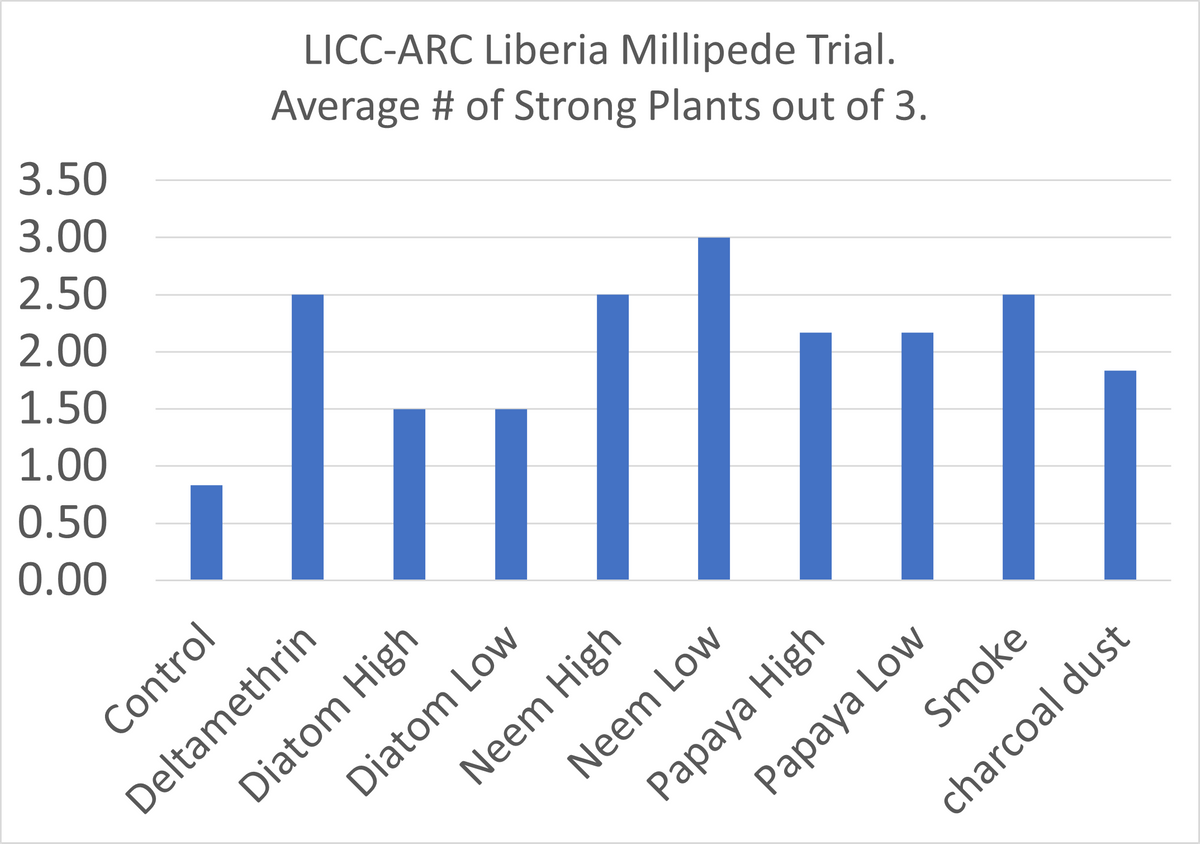Introduction
Millipede species can cause severe damage to various crops. We have heard reports of heavy damage from West Africa, but also more recently from Uganda. Many crops are susceptible to feeding at the seedling stage, including maize (Zea mays), beans (Vigna spp.), pumpkin and melons (Cucurbita) and okra (Abelmoschus esculentus). Continuous mulch used to control erosion and conserve moisture seems to provide a good habitat for millipedes. Effective chemical controls are expensive and difficult to obtain for many rural farmers. Thus, we are trying to identify locally available products that might reduce damage. These experiments are just the beginning of this effort, and we are planning to continue investigating local options for millipede control. Students conducted these experiments at the Agriculture Research Center (ARC) on the campus of Liberia International Christian College in Ganta, Liberia in March 2023. Many of these treatments were conceived during a training program on research principles with agriculture students at the ARC. We are very thankful for the partnership of these students and the ARC leadership.
Methods
The first round of experiments conducted in hill plots (planting stations) identified potentially promising treatments. Based on this first screening trial, a second experiment was designed with 10 treatments, 2 replications, and 3 crops (Zea mays, Cucurbita moschata, and Vigna unguiculata). Each plot was a hill plot of 3 seeds. Table 7 explains treatments tested in the second experiment.
| Treatment | Form | Rate of application |
|---|---|---|
| Control | N/A | 0 |
| Deltamethrin | Powder | 5 ml |
| Papaya tea - low rate | Liquid | 5 ml |
| Papaya tea - high rate | Liquid | 15 ml |
| Neem tea - low rate | Liquid | 5 ml |
| Neem tea - high rate | Liquid | 15 ml |
| Smoke | Semi-solid | thin layer |
| Diatomaceous earth - low rate | Powder | 5 ml |
| Diatomaceous earth - high rate | Powder | 15 ml |
| Charcoal dust | Powder | 15 ml |
We made “tea” treatments from crushed, dried leaves and applied “tea” treatments at a rate of 30 ml dried leaves/250 ml water for both papaya and neem. The other treatments we tested include smoke (greasy grill grime), diatomaceous earth at two rates, charcoal, deltamethrin (a commercial chemical), and a control with no treatment. We placed seeds into the planting station (hill), then applied the treatment directly over the top of seeds. We then covered the seed with soil, added 2.5 cm of fine mulch, and irrigated the field. Three days after emergence, we recorded the number of strong plants, number of weak plants, and number of seeds that did not germinate.
Results and discussion
We calculated averages of data points across treatments to determine which treatments might be most effective. An analysis of variance was conducted treating the three different crop species as replications for a total of 6 replications per treatment.
The most promising local treatments were neem teas (both high and low rates) and smoke (greasy grill grime) (Figure 10). These were significantly different than the untreated control at the P=.01 level. Neem tea treatments were similar to the chemical control, deltamethrin. Papaya tea treatments were significantly better than the untreated control at the P=.05 level. Charcoal dust effectively controlled millipede activity on maize and pumpkin but for an unknown reason, we observed no germination of cowpea in both replications for this treatment. Thanks to Ron Fritz for the statistical analysis.

Figure 10. Average number of strong plants out of three seeds in each plot, averaged across 2 replications and 3 crops of maize, cowpea and winter squash for a total of 6 replications per treatment.
We plan to conduct another experiment in Liberia and in Senegal during July 2023. We would love to have others conduct the same treatments or simply try the most promising treatments and report back their results. There is much work left do to develop an effective treatment plan we can be confident in recommending, and the more locations of observations we have, the more confident we can be.